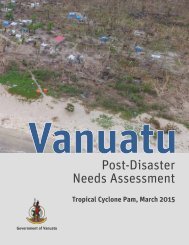Fiji
yqgk302EGjo
yqgk302EGjo
You also want an ePaper? Increase the reach of your titles
YUMPU automatically turns print PDFs into web optimized ePapers that Google loves.
FIJI Post-Disaster Needs Assessment<br />
Table 12: Total Recovery and Reconstruction Needs for the ESLP Sector (F$ million)<br />
Recovery Reconstruction Resilience Total<br />
Micro-enterprise support and preparedness 7 7<br />
Enterprise Recovery Programme (to support<br />
enterprises in the formal sector)<br />
10 10<br />
Expansion of existing social benefit scheme 7 7<br />
Capacity building of Government agencies and CSO’s<br />
that support micro enterprises<br />
Skills Development & Business Confidence<br />
Programme for construction sector using<br />
Employment Intensive Infrastructure Programmes<br />
(EIIP)<br />
Child Labour monitoring, advocacy and withdrawal<br />
programme<br />
Study on the <strong>Fiji</strong> National Provident Fund (FNPF) on<br />
the impact of withdrawals for disasters and social<br />
security support programmes for informal workers<br />
3.5 3.5<br />
3 3<br />
0.5 0.5<br />
0.5 0.5<br />
Total 31.5 31.5<br />
Source: Estimations by Assessment Team.<br />
Note: A detailed breakdown of recovery needs by sector is included in Annex 2.<br />
2.3 Disaster Impact on Quality of Life<br />
While the overall economic impact of disasters varies widely, it is always significantly negative on the quality of life of the<br />
affected population, particularly in the case of more vulnerable population groups.<br />
Reliable quantitative procedures exist to estimate disaster impact at the macroeconomic level, but methodologies to<br />
quantitatively estimate disaster impact at the personal or household level have lagged behind, often concentrating only<br />
on qualitative means of assessment. The Human Development Index (HDI) was used as a proxy quality of life indicator;<br />
however, the HDI is relatively static and does not lend itself to measuring impact on quality of life caused by a sudden<br />
disaster, and is not available in all countries nor at sub-national levels.<br />
To estimate the changes in quality of life following TC Winston, a composite measurement index was estimated based on<br />
relatively simple indicators, and data was collected during the relatively short duration of this PDNA. 42 This approach was<br />
successfully applied and tested during the recent PDNAs following the 2015 Nepal earthquake and Myanmar floods and<br />
landslides. 43<br />
The following sectoral indicators are used in estimating disaster impact on quality of life for the affected population:<br />
<br />
<br />
<br />
<br />
<br />
<br />
<br />
<br />
disease outbreaks arising from the disaster;<br />
<br />
<br />
<br />
<br />
In addition to the above, whenever agricultural production losses were high in comparison to normal productions volumes,<br />
which may occur as a result of slow-evolving disasters, an additional indicator measuring food insecurity may be added.<br />
42<br />
Jovel, Roberto. Estimation of Disaster-Induced Losses to Define Post-Disaster Recovery Requirements, in Disaster Recovery: The<br />
Governance, Economics, and Social Impacts, Asian Disaster Management News, Volume 22, Asian Disaster Preparedness Center (ADPC),<br />
Bangkok, Thailand, 2015.<br />
43<br />
See Myanmar Post-Disaster Needs Assessment on Floods and Landslides, July–September 2015, Government of the Union of Myanmar,<br />
November 2015.<br />
36 Tropical Cyclone Winston, February 20, 2016



